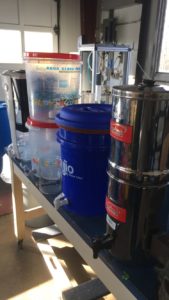Research Interview with Hannah Wharton:
Author: Stephen Stamegna
Background: Hannah Wharton is a senior civil engineering student and an undergraduate member of the Kumpel Research Group at the University of Massachusetts, Amherst. She is currently pursuing her Honors Thesis in the field of drinking water treatment.
Q: Could you tell me a little bit about your thesis?
A: I’m testing the effectiveness of different household drinking water treatment devices. Some of these devices function through filtration and some through disinfection. I’m measuring the log removal of E. coli and total coliform when water is passed through each device. Basically, the log removal refers to the difference between the initial and final concentrations of each contaminant in the water after when it has passed through the treatment device.
Q: What do you hope to achieve through this research?
A: There is not currently a global standard for how effective household drinking water treatment devices should be. In particular, there is not a standard method for how these devices should be tested nor is there a requirement for the level of contaminant removal that they should meet. That being said, my hope is to develop a standard testing method and a standard metric for the log removal of both E. coli and total coliform.
Q: As of now, what are your methods for conducting the lab tests?
A: I measure the initial concentrations of E. coli and total coliform before the water is passed through each device. Then, I run the water through the device and measure the final concentrations afterwards. This is all done using IDEXX bacteria testing.
Q: Have you experienced any complications in your research?
A: Yes. We have been using water from the Mill River near the Amherst Wastewater Treatment Plant on the UMass campus. However, it has been difficult to measure the log removal of E. coli and total coliform. Basically, the initial concentrations are very high and the final concentrations are so low that they do not produce any measurable results.
Q: Have you figured out how to solve that complication?
 A: We figured that it would be possible to measure the log removal if the initial concentrations were even higher than those of the Mill River water. So our first attempt to solve the issue was to use secondary effluent from the Amherst Wastewater Treatment Plant. However, the same issue has risen with this water as well. These observations have raised some noteworthy points. It is interesting that the initial concentrations between the Mill River water and the secondary effluent are so similar. Additionally, if the final concentrations are so low, these devices are most likely very effective at removing contaminants. This is a good thing, but it makes it difficult to label metrics to the effectiveness each device.
A: We figured that it would be possible to measure the log removal if the initial concentrations were even higher than those of the Mill River water. So our first attempt to solve the issue was to use secondary effluent from the Amherst Wastewater Treatment Plant. However, the same issue has risen with this water as well. These observations have raised some noteworthy points. It is interesting that the initial concentrations between the Mill River water and the secondary effluent are so similar. Additionally, if the final concentrations are so low, these devices are most likely very effective at removing contaminants. This is a good thing, but it makes it difficult to label metrics to the effectiveness each device.
Q: How does your research relate to the research group at large?
A: The research group mission consists of a focus on drinking water quality and intermittent water supply (IWS) through international projects, especially those in developing countries. A lot of times, the household drinking water treatment devices that I am working with are used in developing countries that use IWS as a means of distributing water.
Q: Why did you get involved in research as an undergraduate student?
A: I think that research gives you a great hands-on experience through lab work. You get to develop knowledge and skills that you have learned in the classroom and put them to practice in real-world applications. I also enjoy the challenge of having a research question that I am trying to pursue.
Q: Why did you choose your project in particular?
A: At an early stage in my college career, I wanted to be involved on campus. So I joined Engineers Without Borders (EWB) and I was able to travel to Kenya to work on drinking water access projects. Through these experiences, I saw the complications associated with drinking water in developing countries. This inspired my interest in pursuing research in the drinking water treatment field. I think it is really important to have reliable drinking water treatment systems, especially in areas where the water is not safe to drink and leads to a lot of public health problems.
Additional Material: Below are some pictures of Hannah’s lab setup and the different drinking
water treatment devices with which she is working.
